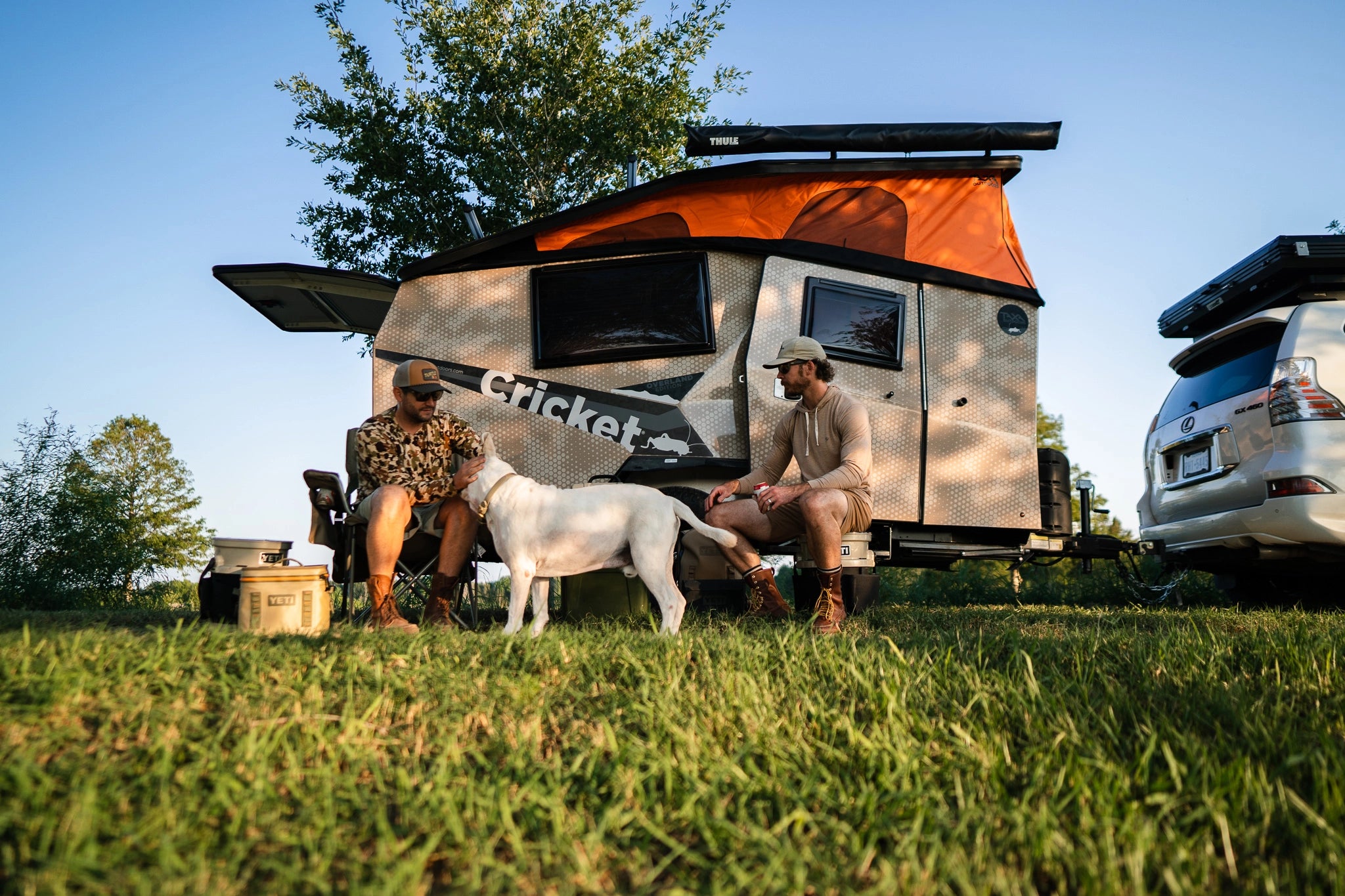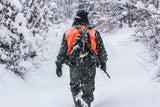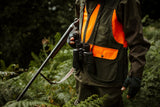When you’re out in the wild experiencing the thrill of the hunt, a solid basecamp setup means spending more time engaging with nature and less time fiddling with your campsite. The last thing you want after a long day of hunting is to come back to a camp that’s been ransacked by bears, destroyed by a fallen tree, or become waterlogged by inclement weather.
While preparing a functional, efficient campsite may not be the most exciting task for every hunter, we’re giving you the ultimate guide to hunting camp setups to help you make the most of your next hunting trip.
What are hunting basecamps for?
A basecamp serves as a central location from which hunters operate during an expedition. Its primary purpose is to provide a comfortable and strategic point for hunters to plan, prepare, and return to during their activities.
The size and form of a hunting basecamp can vary widely based on the specific needs and preferences of the hunters. Many hunting basecamps are set up in natural clearings or established campsites within the hunting area, but they can also come in the form of an elevated hideout, a hunting cabin, or a camping vehicle. Some hunters also opt for more portable hunt camps, like a truck bed setup, so they can easily move to other locations as they track game.
How to scout a good place to set up camp
So, how do you build a hunting camp? The first step is scouting a good place to establish your campsite, as your setup location can significantly impact your comfort, safety, and hunting success. Determining your location should take into account certain factors like the duration of your trip, the terrain, and the specific game you're after.
Here are a few tips for scouting the best campsite for your situation:
- Research game habits - understand the habits and patterns of the game you're hunting. Choose a campsite that positions you in proximity to their likely paths, such as near water sources, game trails, or feeding areas. You can use topographical maps or aerial images to assist in pinpointing the best spot.
- Consider terrain and duration - assess the terrain and the duration of your hunting trip. In rugged or remote areas, prioritize proximity to your hunting grounds to minimize travel time and energy expenditure. For longer trips, balance proximity with factors like water availability and shelter.
- Prioritize safety and shelter - ensure your campsite offers safety and shelter from the elements. Look for level, well-drained ground for setting up tents or shelters. Seek natural windbreaks, and avoid areas prone to flooding or avalanche risk.
- Access to essential resources - choose a campsite with access to essential resources such as clean water, firewood, and suitable sanitation facilities. Proximity to these resources can enhance your camping experience and minimize your environmental impact.
- Compliance with regulations - always adhere to local hunting and camping regulations. Obtain any necessary permits, respect property boundaries, and follow wildlife conservation laws. Responsible hunting and camping ensure a positive experience and protect the environment.
Hunting camp essentials
Now that you’ve found the perfect spot, it’s time to decide what hunting camp gear you’ll need to bring. Below is a list of hunting camp essentials and useful items, as well as a few things that would be nice to have along to make your camping experience as well-equipped as possible.
Essentials
- Tent/shelter
- First aid kit
- Food and water
- Sleeping bag
- Navigation tools, such as maps and GPS
- Gun/hunting weapon of choice
- Flashlights
- Fire starting kit
- Food storage
- Hunting clothes
- Field dressing kit
Useful
- Camp furniture, like portable chairs or tables
- Hunting camper/trailer
- Multi-tool
- Hygiene kit
- Tarp or rainfly
- Lantern
- Axe or saw
- Binoculars
- Communication device

Luxuries
- Camp oven or grill
- Camp shower
- Portable power source
- Camp entertainment, like playing cards or books
- Bug repellent
- Wildlife camera
Other hunt camp ideas
While your hunting camp gear and location are essential considerations for a successful trip, here are some other ideas for your setup, food storage, and camping etiquette as well:
Campsite setup
- Pitch tents/shelters - set up tents or shelters away from the cooking and food storage areas. Ensure tents are secured properly to withstand weather conditions.
- Create a cooking area - establish a designated cooking area with adequate ventilation. Use a camp stove or fire ring if fires are allowed, and keep it away from tents and flammable materials.
- Camp orientation - there are four main campsite layouts, the L-Shape, Curved, Angled, and Straight. Set up your campsite based on your desired level of privacy, what paths through camp will be most active, and maintain a good distance between cooking, bathroom, and sleeping areas.
- Dispose of waste properly - use a portable toilet or dig a cat hole for human waste disposal. Pack out all trash and litter.
Food storage and meal prepping:
- Food storage - store food in bear-resistant containers or bear bags in bear country. Hang food at least 10 feet off the ground and 4 feet away from trees to prevent bears from accessing it.
- Use sealed containers - store food in airtight, odor-proof containers to prevent smells from escaping. Ziplock bags and sealable containers work well.
- Avoid cooking strong-smelling foods - hunting camp meals should limit strong-smelling foods like bacon or fish, especially at night. Opt for milder options so you won’t attract animals.
- Plan meals - prepare a meal plan and pack only the food you need (make-ahead meals for hunting camps can make your life easier). Consider lightweight, non-perishable items like dehydrated meals for longer trips.
- Wash dishes away from camp - dispose of dishwater away from camp, ensuring it doesn't attract animals.
Common sense recommendations:
- Follow Leave No Trace principles - minimize your impact on the environment by leaving your campsite as you found it. Leave natural and cultural features undisturbed.
- Be fire smart - familiarize yourself with local fire regulations and practice responsible fire management.
- Be considerate of others - if you're hunting in an area with other campers or hunters, respect their space and maintain a quiet and courteous campsite.
- Know the rules - research and follow hunting and camping regulations for your specific location. Obtain necessary permits and licenses.
Organizing tips for quick setup & teardown
You can further streamline your camp’s organization by having separate bags for each kind of gear you’re packing, so you don’t have to waste time rifling through disorganized bags. This will also simplify the process of packing up your hunting camp when it’s time to leave.
One way to make your campsite quick and efficient for both setting up and tearing down is by utilizing a portable hunt camp. Using an RV, hunting trailer, or adventure vehicle can greatly simplify your setup, as many of these were designed for quick and efficient setup and teardown, making it easier to change locations as you track animals.

Should you get a hunting camper?
Preparing for hunting season and setting up a campsite that optimizes your hunting experience requires careful planning and attention to detail. From selecting the ideal location and ensuring proper food storage to following ethical and environmental guidelines, a well-organized campsite can significantly enhance your hunting trip. Even better, a mobile basecamp like TAXA’s Woolly Bear (or an enclosed model like TigerMoth) is a great way to upgrade any hunting camp setup. Woolly Bear features an 830-pound cargo capacity, full-size outdoor kitchen, and an elevated platform that accommodates most two-to-three-person tents.
All of our adventure vehicles can be customized with a camo series wrap as well. Just select your favorite TAXA habitat and choose from one of 12 modern camo prints to outfit your ride! Check out our lineup of habitats and chat with one of our adventure specialists today to get started.

